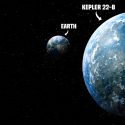Some of the planets in our Solar System are gigantic. But what if they got even bigger? Let’s go up the planetary size chart and see what kind of chaos doubling the size of every planet would make. What would it be like to live on a super-Earth? How big would Jupiter need to get to become a star? And would Pluto finally regain its planetary status?
Doubling the radius of every planet in the Solar System would make each of them eight times more massive. But you wouldn’t need to worry about our Solar System’s great ball of fire getting bigger and hotter. For the sake of this experiment, let’s keep the Sun the same size it already is. But could the gravitational pull of a super-Jupiter kickstart a chain of events that would result in the destruction of the Solar System?
MERCURY
At its current size, the rocky planet closest to the Sun is only slightly larger than our Moon. Doubling it in size would make it nearly half as massive as Earth. And despite the fact that Mercury stopped being volcanically active 3.5 billion years ago, expanding its interior would mean all that internal energy would need to escape somewhere. So there could be some more explosive volcanic eruptions in Mercury’s future.
VENUS
Venus is very similar in size to Earth. But one of its many differences is that its atmosphere is so thick that the surface pressure is 95 times stronger than our own. Increasing in size and mass, Venus’ increased gravity would pull the atmosphere even closer to its surface. This could result in the atmosphere becoming so dense that walking through it would feel more like walking through water. Except you’d really be walking through incredibly thick carbon dioxide.
EARTH
If Earth expanded to twice its size, the first big change you’d notice would be that you’d feel a lot heavier. Within seconds, you’d go from your 75 kg (165 lb) weight seeming like it was 150 kg (330 lb). That would be because the force of gravity pulling on you would be twice as strong. Better hit the gym to strengthen up fast because this wouldn’t be so easy on your body.
Your heart would need to work twice as hard to pump blood around, and pressure would build up on your joints. Jumping, flying or sending rockets into space could become a thing of the past. You’d need much more fuel, power and money to leave Earth’s surface and travel through its even thicker atmosphere.
MARS
If the red planet ballooned to twice its size, there’s a chance you could barely recognize it. What was once a dry, desolate place could eventually transform into a more Earth-like planet with oceans, rivers and a thick atmosphere. Mars lost its magnetic field and then its atmosphere, likely because of chemical changes inside its core. If the Martian core got bigger and hotter, it could restart the magnetic field. That, in turn, would protect Mars from solar winds and give it a chance of kick-starting life.
JUPITER
Doubled in size, Jupiter would continue to be an intimidatingly huge planet. It would stay 318 times larger than Earth, and 2.5 times more massive than all the other planets combined. And the impact of this would be so huge that it would likely shift the actual center of our Solar System. See, all the planets in the Solar System don’t exactly revolve around the Sun.
They orbit the common center of mass, or the barycenter. Thanks to Jupiter’s normal size, this barycenter is about 48,000 km (30,000 mi) away from the center of the Sun. Doubled up, this point in space would move even further away from the Sun. You’d see material from the asteroid belt being pulled toward Jupiter, or further out into the Solar System.
But even this big, Jupiter wouldn’t be massive enough to become a full-blown star. To do that, it would need to increase to 85 times its current mass. Though it wouldn’t be far off from star status. At thirteen times its original mass, Jupiter could become a brown dwarf star.
SATURN
With a bigger Saturn, you could kiss its beautiful rings goodbye. The monumental increase in the planet’s surface gravity would upset the balance of the ring materials, as well as Saturn’s five small moons. They’d start falling toward its surface at a higher rate. Saturn is already slowly losing its rings. Every 30 minutes, enough material containing water falls down to the planet to fill an Olympic-sized swimming pool.
URANUS
Beyond its added heft, not all that much would change for the ice giant Uranus way out on the edges of the Solar System. It would continue holding the record for the stinkiest planet. If doubling Uranus’ size would mean doubling the amount of hydrogen sulfide in its upper atmosphere, this stinker might spread an even stronger stench of rotten eggs. Ew. I wouldn’t go near this planet.
NEPTUNE
Neptune’s fate wouldn’t be too different from its giant frozen neighbor. Except Neptune’s increased gravitational pull could eventually lead to the disappearance of some or all of the billions of icy objects located outside its orbit. Neptune has already swallowed up the equivalent of 7 to 10 times the mass of Earth in material from the Kuiper Belt.
PLUTO
If Pluto doubled in size, it could be back on track to regain its official status as a planet. If its added mass and gravity could manage to pull away debris from its surrounding neighborhood, it might just be able to rejoin the rest of the family. So it’s safe to say that all the planets doubling in size wouldn’t exactly bring about a cataclysmic end of the Solar System. It would, however, cause a little chaos. But not nearly as much as if the Sun became big enough to swallow Earth.
Sources
- “Mercury”. 2022. solarsystem.nasa.gov.
- “How Small Is The Smallest Habitable Exoplanet?”. Paul Scott Anderson. 2019. earthsky.org.
- “Venus”. 2022. solarsystem.nasa.gov.
- “Newton’s Law Of Universal Gravitation “. 2022. physicsclassroom.com.
- “What Would Happen If Gravity Was Doubled?”. 2014. howitworksdaily.com.



























